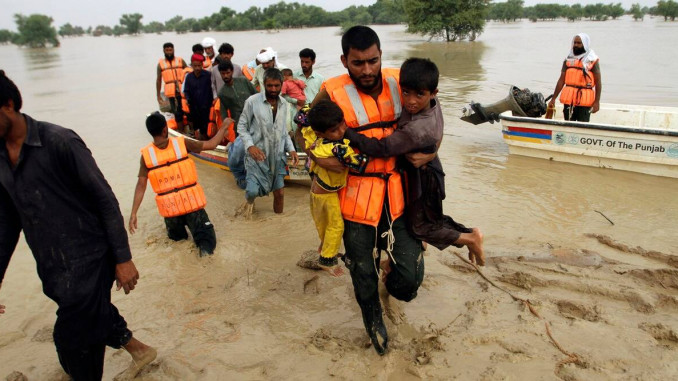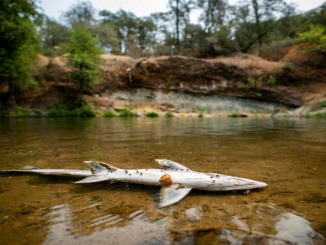
Pakistan is facing an extreme level of rain and floods. Pakistan usually has multiple cycles of monsoon rain, but this year it’s already in its eighth cycle, with another cycle possible in September. Two of the hardest hit provinces have received 400 percent more rain than the 30-year average. So far this year, the levels of rain have exceeded what caused the catastrophic floods of 2010.
One-third of the country is under water, 33 million people have been displaced, over 1,000 are injured, and thousands are missing. Those who live in the rural areas have lost everything. Whole villages have gone under in the floods. Millions of homes have been destroyed, and infrastructure, such as roads and bridges, have been damaged or destroyed, along with millions of acres of farmland. Tens of thousands have had to flee their homes in Northern Pakistan. Many remain camped on roads without even a tent to give them shelter. Many more still need to be rescued.
And quite possibly, the worst is yet to come in the form of more rains, floods, epidemics in the affected areas, and certainly a worsening of already dire economic conditions. People in the affected areas already lived in extreme poverty before the floods. Many houses in the villages were built of mud, and were totally washed away. A majority of people made their living through agriculture and livestock, most of which has now been destroyed. Houses and streets are also under water in major cities. People are without electricity, gas, clean drinking water, and food. Many are also without cellphone networks and internet connections. For this reason, the level of devastation is unknown, as the people on the ground cannot communicate with the outside world.
The Pakistani government is incapable of responding to the floods
The government declared a state of emergency, using the army and rescue workers to rescue and evacuate people, set up flood relief centers, and provide some aid. But rescuing those in remote regions is extremely difficult. The government of Pakistan knew about the upcoming monsoon season but made almost no efforts to prepare for the potential floods, or even to warn people to move to safety. Right before this tragedy struck there had been tensions and conflicts. Pakistan’s former Prime Minister, Imran Khan, lost his majority in the parliament, and thus could no longer remain as Prime Minister. This political shift caused political and civil unrest. After the floods devastated the country, the major political rivals started the blame game — pointing their fingers at the other political factions, to focus attention away from their lack of preparation for the flooding, even though they had governed the country for decades.
Pakistan is a former British colony and suffered through almost a century of colonialism. The region faced extreme poverty as the colonizers stole most of its wealth and resources. And since independence in 1947, the majority of the population has remained poor and the country never developed a solid infrastructure. Pakistan has been forced by the International Monetary Fund (IMF) to implement austerity measures, and their economy was already in bad shape long before the floods. They certainly don’t have enough resources to help their own people in normal times, let alone in a time of crisis.
People in Pakistan and around the world are sending donations, but it is just a drop in the bucket for what is needed. Government officials have asked for international aid and the United Nations has appealed for an emergency fund for Pakistan. While the wealthiest countries in the world have contributed billions to the war in Ukraine, what they will contribute for Pakistan relief? And certainly, a one-time fund is not anywhere near enough to respond to the current damage, let alone to the up-coming climate disasters that Pakistan will continue to face.
But who is really to blame?
Pakistan, in the recent period, has faced a cascade of climate challenges, including heat waves, forest fires, and flash floods. Pakistan has the highest number of glaciers after the arctic polar region, and they are melting due to the increase in global temperatures. The recent floods around the world disproportionately affect Pakistan, even though it contributes so little to the carbon footprint that causes climate change.
Scientists warned decades ago about the dangers of releasing greenhouse gasses into the atmosphere, but major industries, especially petroleum and oil have denied this science and played an active role in promoting climate change denial to keep their profits rolling in. And the governments in the wealthy countries have defended the interests of these companies over the health and safety of the world’s peoples and the climate. The excessive release of greenhouse gases from factories, mainly in developed nations, such as the U.S., Japan, and Germany, is mainly responsible for the climate crises of the 21st century. Agriculture-based nations like Pakistan, while they contribute relatively little to the release of these gases, face disproportionate consequences.
Even if the Pakistani government had been better prepared, the severity of the rains and subsequent floods and the devastation would have caught any existing government off guard. This is the kind of disaster no government in the world is prepared for. This is not a single event; it is a horrible preview of the upcoming future of severe climate crises. Capitalism is making these disasters the new normal, with workers and the poor of the world, particularly those of the Global South, bearing the brunt.



